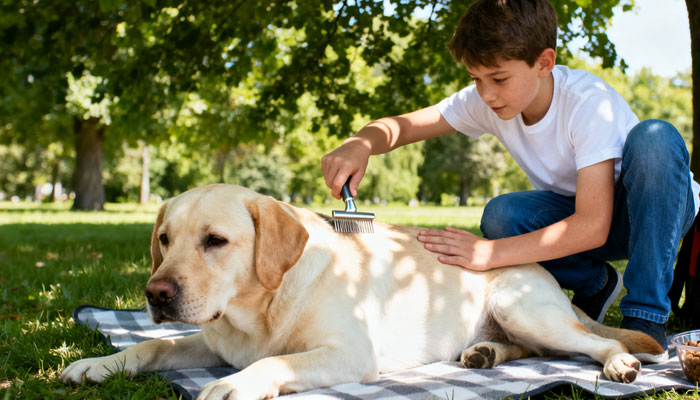Fleas on Dogs: Five Methods for

Fleas on dogs are a frustrating issue, not only affecting your dog’s health but also potentially posing risks to your home environment. Therefore, fleas on dogs have become a critical concern for pet-owning households. So, what should you do when your dog has fleas? How can you effectively manage fleas on dogs and prevent their proliferation in daily life?
Dogs infested with fleas often exhibit unusual behavior, such as frequent biting or scratching of their body or specific areas. This is typically a sign of parasitic infestation. As an owner, if you notice such behavior, promptly check for fleas—this is a crucial observation step in flea management. Carefully examine your dog’s skin for redness, swelling, or red spots. If these symptoms appear, it’s a strong indication of a flea infestation, requiring prompt treatment.
Below are several practical flea control methods to help you effectively manage fleas on your dog:
1. Flea Control: Flea Spray
Flea sprays demonstrate noticeable effectiveness and are convenient to use, though domestically produced options remain limited. Note that the sudden spray motion and sound may startle your dog. Calm your dog beforehand to prevent stress reactions and ensure a safe, smooth treatment process.
2. Fleas on Dogs: Spot-On Treatments
Spot-on treatments are a common long-term solution for fleas on dogs. Apply the medication directly to the skin on the back of the neck, where it is absorbed and takes effect. However, domestically produced options are limited. Purchase only from reputable sources to ensure quality and avoid using substandard products that could harm your dog’s health.
3. Fleas on Dogs: Pet Shampoos
For dogs with only mild flea infestations, pet shampoo can serve as a supplementary measure. Note that if your dog has a severe, heavy parasite infestation, pet shampoo has limited effectiveness and cannot completely eliminate fleas. In such cases, it must be combined with other more potent prevention methods, such as flea spot-on treatments or sprays.
4. Fleas on Dogs: Flea Collars
Flea collars primarily serve a preventive role in flea control on dogs, though they can also offer some benefit against mild infestations. Their overall effectiveness, however, is relatively limited. Additionally, some dogs may develop allergic reactions when wearing flea collars. Therefore, it’s crucial to test for allergies before use. If discomfort occurs, remove the collar immediately and switch to alternative prevention methods.
5. Fleas on Dogs: Flea Combs
Flea combs are physical control tools for dogs, only removing adult fleas and eggs from the dog’s body surface. They have no effect on fleas hiding in the environment. Therefore, while using a flea comb, it is also necessary to clean and disinfect the dog’s living environment (such as dog beds, carpets, sofas, etc.) to achieve comprehensive flea control.
Important Note: Key Symptoms to Observe for Fleas on Dogs
During flea infestations, closely monitor your dog’s physical condition. After flea infestation, dogs typically exhibit localized hair loss and broken hairs. Affected areas may develop pustules and oozing, while the coat becomes noticeably dull, coarse, and lacking luster. If these symptoms appear, it indicates fleas may have damaged the dog’s skin. Intensify prevention and control measures, and consult a veterinarian for professional treatment if necessary.
admin
-
Sale!

Washable Pet Cooling Pad for Cats and Dogs
$10.99Original price was: $10.99.$9.99Current price is: $9.99. This product has multiple variants. The options may be chosen on the product page -
Sale!

Washable Cat Window Hammock Cooling Bed
$23.99Original price was: $23.99.$22.99Current price is: $22.99. -
Sale!

Tropical Amphibian Rainforest Tank, Lizard Cage
$38.99Original price was: $38.99.$36.99Current price is: $36.99. -
Sale!

Silent 4-in-1 Waterproof Charging Dog Hair Trimmer
$49.88Original price was: $49.88.$47.99Current price is: $47.99.